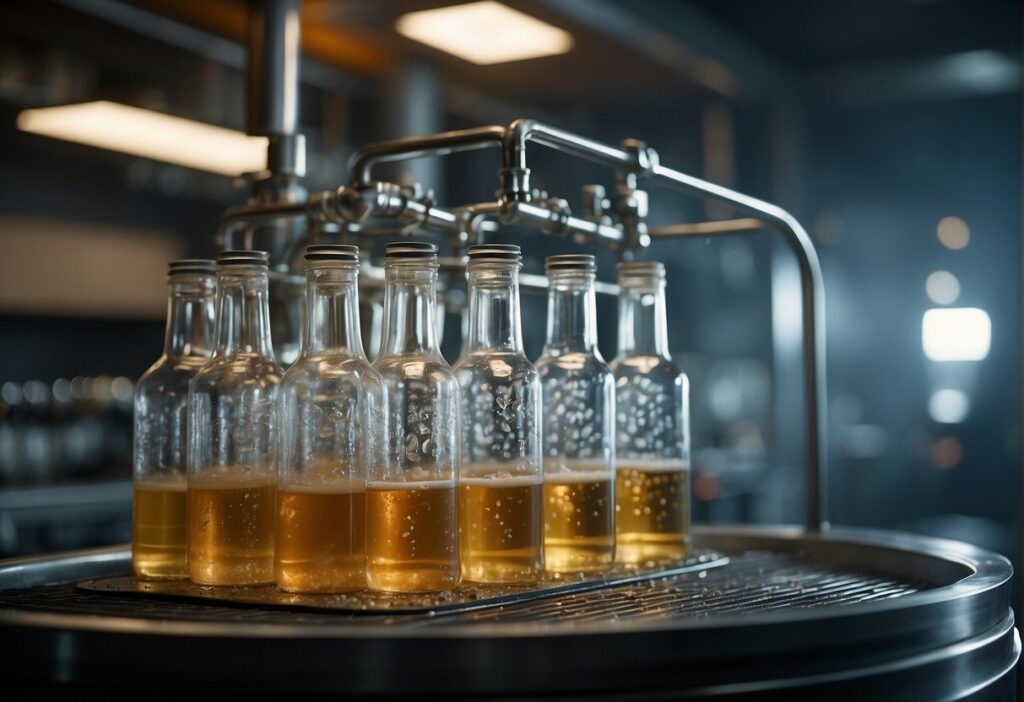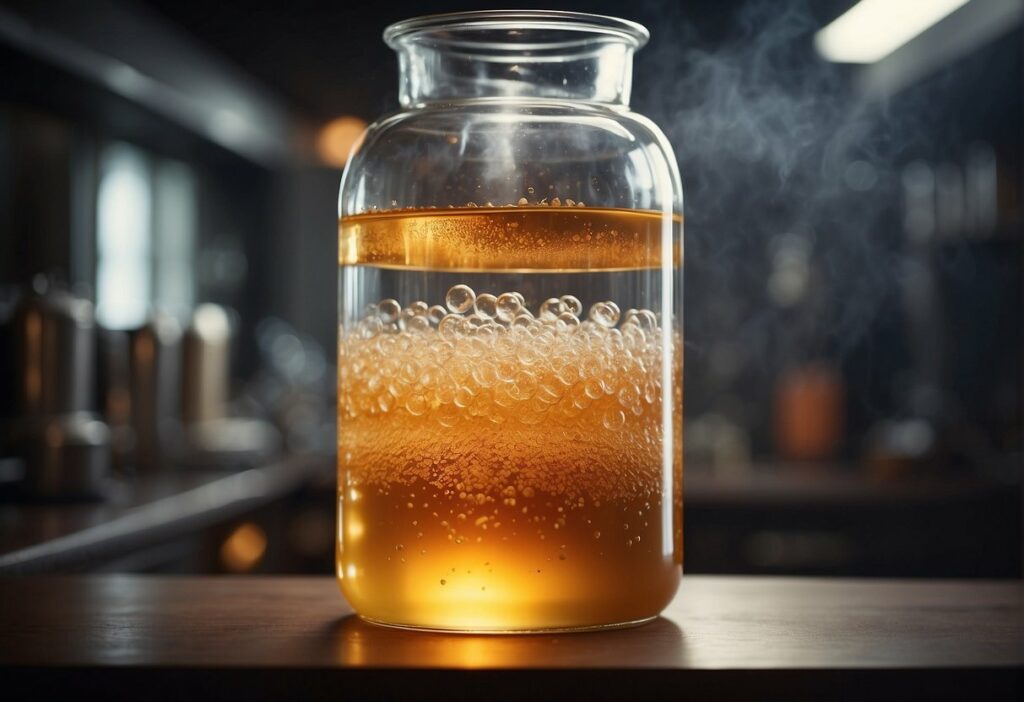Fermentation and distillation are two distinct processes used in the production of alcoholic beverages. Fermentation is a natural biochemical process whereby yeast converts sugars into alcohol and carbon dioxide. This method is an ancient practice and provides the base alcohol required for distillation. It occurs under controlled conditions where yeast breaks down fermentable sugars found in fruits, grains, or other sugar sources.

Distillation, on the other hand, is a purification process that takes the alcohol produced by fermentation and increases its concentration. This is achieved by heating the fermented liquid to a temperature where alcohol vaporizes, then capturing and cooling that vapor back into a liquid form. The distiller can perform this process multiple times to achieve the desired purity and alcohol strength. There are several methods of distillation, with heat distillation being the most common, but other methods like freeze distillation are also practiced in specific circumstances.
Key Takeaways
- Fermentation is a biological process that produces alcohol from sugars, while distillation purifies and concentrates the alcohol.
- The distillation process follows fermentation, elevating the alcohol content by separating it from the mixture.
- These two processes are essential for creating a variety of alcoholic beverages with different characteristics and strengths.
Fundamental Concepts
The production of alcohol hinges on two pivotal processes: fermentation and distillation. Each employs distinct methods to transform raw ingredients into alcoholic beverages.
Understanding Fermentation
Fermentation is the biochemical process where yeast consumes sugar in an anaerobic respiration environment, producing ethanol (the alcohol in alcoholic beverages) and carbon dioxide. This natural occurrence is the foundational step in creating alcohol. The specific gravity and temperature play vital roles in controlling fermentation, as they influence the activity level of the yeasts and enzymes responsible for the conversion of sugars into alcohol. Common substrates for fermentation include grain, grapes, and other sugar-rich materials, which, when mixed with water, create a “must”. In alcoholic fermentation, the absence of oxygen is crucial, as it forces the microorganisms to metabolize sugar for energy without it, leading to the production of alcohol. The secondary fermentation may take place in a barrel or bottle, generating effervescence in drinks like sparkling wines and beers.
Understanding Distillation
Distillation is a method of purification that separates components of a liquid mixture based primarily on differing boiling points. Once fermentation is complete, the distillation process can begin. The fermented liquid, with its blend of water, alcohol, and other components, is heated until the alcohol and other substances with lower boiling points evaporate. These vapors are then condensed back into liquid form and collected. This step can be repeated multiple times to increase purity and alcohol content, a process known as rectification. The temperature control is crucial, as it determines the volatility of the components and their separation efficiency. The end product of distillation is a spirit with a significantly higher alcohol content than what fermentation alone can produce, as seen in spirits like whiskey, gin, and vodka.
Comparative Analysis
This section provides a detailed comparison of fermentation and distillation processes, focusing on their nature, products, and the equipment utilized.
Contrasting Processes
Fermentation is a metabolic process where yeast converts sugars and starches from grains and fruits into alcohol and carbon dioxide. It is the foundational step in producing beverages such as beer, wine, and cider. Distillation, on the other hand, involves the separation of alcohol from the fermented product by exploiting different boiling points. Heat is applied in a still, which causes evaporation and then condensation to collect the distilled spirit like whiskey, gin, and vodka.
Outcome of Fermentation and Distillation
The outcome of fermentation is a liquid containing alcohol with a relatively low ABV (alcohol by volume). Products include beer and wine with ABV typically under 15%. In contrast, distillation yields spirits such as whiskey, rum, gin, tequila, and vodka with a higher concentration of alcohol, commonly above 40% ABV. This involves multiple rounds of rectification and separation to remove impurities and achieve the desired strength and flavor profile.
Equipment Used
The equipment for fermentation includes barrels, vats or fermenters, where the yeast and sugar reaction occurs. For distillation, two primary types of stills are used: the pot still for batch processes, suitable for complex spirits like whiskey, and the continuous still for more efficient, constant production, used in vodka making. The distilled vapor passes through a condenser where it returns to a liquid state, now separated from unwanted compounds based on volatility and boiling point differences.
Practical Applications

Fermentation and distillation are distinct processes that have numerous applications across various sectors. The former is often associated with creating alcoholic beverages and certain food items, while the latter is regularly employed for purifying substances and producing chemical products.
Alcoholic Beverages
Fermentation serves as the foundational step in producing alcoholic drinks, where microorganisms such as yeast break down sugars to yield ethanol and carbon dioxide. This biochemical reaction is crucial for crafting a variety of spirits:
- Beer and Ale: Beer and ale are produced from fermented grains like barley and are often flavored with hops.
- Wine: Made by fermenting crushed grapes or other fruits.
- Cider: Created by fermenting apple juice.
- Sake: Japanese alcoholic beverage brewed from fermented rice.
In contrast, distillation concentrates the alcohol content, creating beverages with higher ABV (alcohol by volume):
- Brandy: Distilled from wine or other fermented fruit juices.
- Whiskey: Typically distilled from fermented grain mash.
- Gin: Distilled from grain and flavored with botanicals such as juniper.
- Rum: Generally made from fermented sugarcane or its byproducts.
- Vodka: Usually distilled from fermented grains or potatoes, notable for its high purity.
- Tequila: Distilled from the fermented juice of the agave plant.
Industrial and Commercial Uses
Distillation is a pivotal industrial process beyond the scope of beverages. It’s used to:
- Purify chemicals.
- Desalinate water, as in removing salt from seawater.
- Produce fuel components and essential oils.
Commercially, fermentation has roles in food science and preservation, including the production of:
- Sauerkraut and Kimchi: Fermented cabbage dishes with health benefits from probiotics.
- Kombucha and Kefir: Fermented drinks are believed to have medicinal uses.
Historical and Cultural Significance
The art of fermentation and distillation carries a profound historical and sociocultural impact. Traditional methods:
- Have shaped regional alcoholic beverages like sake and tequila.
- Influenced the development of brewing and distilling techniques using various apparatus such as the alembic and pot stills.
These processes also reflect sociocultural impact through their roles in religious ceremonies, social gatherings, and economic drivers.
Health and Safety Considerations
Handling of fermentation and distillation processes must address:
- Health: Monitoring the production to avoid toxic byproducts like methanol.
- Hygiene: Ensuring cleanliness to prevent contamination.
- Legislation: Adhering to laws governing the sale and production of alcoholic beverages.
Health benefits from moderate alcohol consumption, such as in red wine, contrast against health risks related to excessive alcohol intake and potential toxicity. Balancing benefits and safety is key to the responsible application of these ancient practices.
Frequently Asked Questions
Understanding the differences between fermentation and distillation is key to appreciating the variety and production techniques of alcoholic beverages.
What are the fundamental differences between the processes of fermentation and distillation in the production of ethanol?
Fermentation is a biological process wherein yeast converts sugars into ethanol and carbon dioxide. Distillation, on the other hand, is a physical separation technique that increases the alcohol content of a fermented liquid by heating it to vaporize its volatile components, which are then condensed back into liquid form.
What characterizes fermented alcoholic beverages in comparison to those that are distilled?
Fermented alcoholic beverages typically have a lower alcohol content and retain more of the original flavors from their ingredients. Distilled alcoholic drinks have higher concentrations of alcohol and often have a more neutral flavor profile, although some flavors can be imparted during the distillation process or from the aging material.
How does the distillation of alcohol differ from its fermentation in terms of chemical changes?
The chemical changes in fermentation involve the conversion of sugars into alcohol and carbon dioxide by yeast. Distillation does not involve a chemical change but rather a purification process, where the physical separation of alcohol from the water and other components occurs due to the differing boiling points.
Can you identify which alcoholic drinks are produced solely by fermentation and which require distillation?
Drinks like beer, wine, and cider are produced solely through fermentation. Spirits such as vodka, whiskey, and rum require distillation after fermentation to achieve higher alcohol content and purity.
In the context of alcohol production, how do the purposes of fermentation and distillation differ?
Fermentation’s purpose is to create alcohol through the biological activity of yeast. Distillation serves to concentrate the alcohol created by fermentation, remove impurities, and sometimes to alter the beverage’s flavor profile.
What are the distinct outcomes of fermentation and distillation in the brewing industry?
In the brewing industry, fermentation yields beverages with varied alcohol content and flavors based on the ingredients and yeast used. Distillation can further refine these fermented products into spirits with higher alcohol content, often leading to a greater range of commercial products with distinct tastes and properties.